Games
PCB
Archive
Chip
Archive
Cart/Box
Scans
Articles
Peripherals
Prototypes
Unreleased
Games
Rarities
Homebrew
Emulation
Links
Email: snes_central@yahoo.ca
Retro VGS - Why it failedRetro VGS - Why it failed |
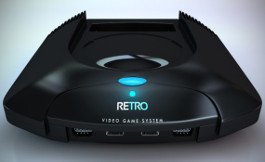 The Retro VGS, which recently met with failure in a Indiegogo, is a case example of how not to market a retro product. I comment on why it failed, and give suggestions on how it could succeed. By:
Evan G
|
Before we start, I fully expected the Retro Video Game System (VGS) to fail, from the very first time it was announced. In late January, Mike Kennedy aka SoCalMike made a thread on Nintendo Age asking for developers. To me, this was an odd place to ask for this kind of help, since that forum is predominantly catered to the collecting scene rather than producing video games. This, for me, was the very first step in what was a series of catastrophic errors made by the Retro VGS team that led to its demise. Perhaps the best place to see a blow-by-blow breakdown of this train-wreck is this massive thread on Atari Age. It became the central location for near real-time information on what was happening. The full drama led to it becoming this massive 100+ page behemoth, so if drama is your thing, bring a coffee.
As a person running a website dedicated to a retro gaming console, it may not be surprising that I like retro-style games. However, that interest does not translate to a desire to return to the era of the SNES, when games cost upwards of $80 (true fact, I spent $75 Canadian in 1997 to buy a used copy of Chrono Trigger - ouch!). SoCalMike is obviously someone who loves the old days so much that he decided to actually attempt to recreate this era. However, I think it is safe to say that not many share this feeling. Here is a list of why this was never going to work.
Why the Retro VGS was destined to fail
No previous record of success
Although some may dispute this, I would contend that SoCalMike's previous ventures were not a great indicator of future success. The most famous thing that SoCalMike tried to do for the retro gaming community was his auction site, Chase the Chuckwagon. This site popped up around the same time as another site, with a much more marketable name, GameGavel. Both were auction websites similar to Ebay, but with the promise of lower fees and better catering to the gaming community. After a while, the owner of GameGavel decided to get out of the business and sold it to SoCalMike. Almost immediately after buying it, he switched to the much more marketable name. This was a smart move, but by that point, I doubt anyone was going to make the switch from Ebay. SoCalMike did try to boost the profile of his auction site by hosting several high end auctions for free. In the end, this didn't really drive interest in the site, which cannot compete with the security and visibility of hosting auctions on Ebay or Amazon. At present time, GameGavel is essentially a storefront for two active sellers, who no doubt have some sort of listing deal.
The other notable venture by SoCalMike is the Retro gaming magazine. Again, the first problem with this is the name - there was already a well established retro video game magazine called Retro Gaming. He successfully got this funded in two Kickstarter campaigns with the promise of high end coverage by veterans of the gaming press. I personally haven't read Retro, but the complaints have arisen that they were late on delivering issues, and that the layout and article quality wasn't always the greatest. Perhaps the biggest problem is that there is a reason why video game magazines are no longer prolific - the Internet. Right now, you can go to a plethora of websites and video sites that cater to video game enthusiasts of all audiences. I'd be shocked if a third year of issues actually gets published, especially if they need to go back to Kickstarter.
As for the other two members of the Retro VGS, I'd argue that though they did have some success back in the day, they have produced nothing of note in the past 10-15 years. Steve Woita is a notable member retro video game community, most notable as the programmer for the ultra-rare Atari 2600 game, Quadrun, and the unreleased Garfield game that pushed that system to the limit. As far as nostalgia goes, I could see why he latched on to this project. Looking at his website, it appears he has been programming games in Flash, a platform that is going the way of the dinosaur with the advent of HTML5. His credits give him some tangential involvement in some games with 3DO back in the late 90s and early 2000s, but nothing of note in the past 10 years. John Carlsen is the architect of the hardware, but it is tough to judge his credentials. He claims to have worked on creating a "Playstation", but apparently it was never released. Shortly after the failure of the Indiegogo campaign, he left the project.
No hardware
One of the first problems with the Indiegogo campaign is that there was no working prototype of the system. Of course, it was hard to have a working prototype when the specs kept changing, even within a few weeks of the campaign. The first idea was that it would have a field programmable gate array (FPGA). People were excited by the prospect of a FPGA, because it would allow actual retro games to run almost natively (better than emulation) and output in full HD. However, the cost of this was going to be high, so at the last minute, they decided to abandon it. In its place, they made a vague reference to an ARM-processor system that would be dedicated only to new games. After crying out that "this is not like the Ouya", they put some initial specs that were actually worse than the Ouya. There was no way a crowdfunding scheme would work without some working hardware. I'm sure that the people who backed Mighty No. 9 will tell you what a folly it is to back a project that is only in a conceptual stage, and that was backed by true industry veterans.
The hilarious part was when they tried justifying not having any hardware to show. At first, they tried to claim that they didn't want to show anything because they wanted to patent components to this system. Patenting anything from a console known as the "Retro VGS" is patently ridiculous. After that, they produced this ridiculous video which showed John Carlsen pointing out how it has a power supply, and showed some silly manipulation of an object on screen. They tried to obscure their "prototype" with a clear console casing, but it was quickly determined that it was two inexpensive off-the-shelf prototyping boards. Though this is funny, this is also borderline fraud.
Laughable hardware demonstration
To add to the previous point, they showed off some things claiming to be "prototypes", which was almost embarrassing. Let's have a look at the first "prototype", which was simply a piece of cardboard with some off the shelf components stuck on.
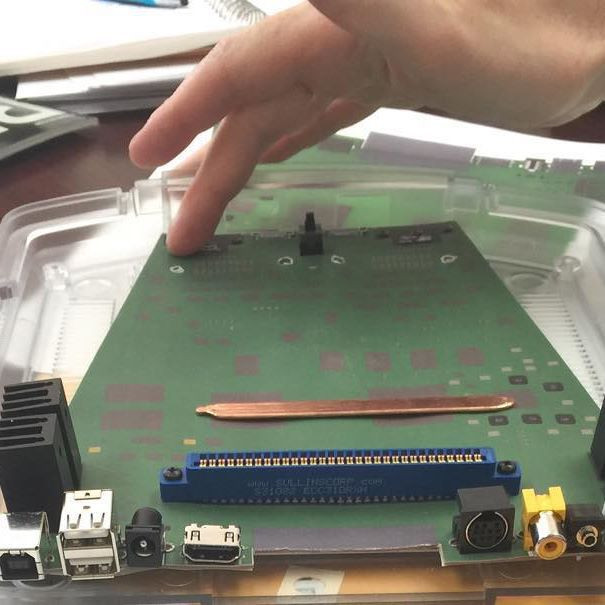 |
| First "prototype" of the Retro VGS |
You'll note that there isn't a single thing on that piece of cardboard that could run a program. Another laughable thing was their working "prototype" of their controller:
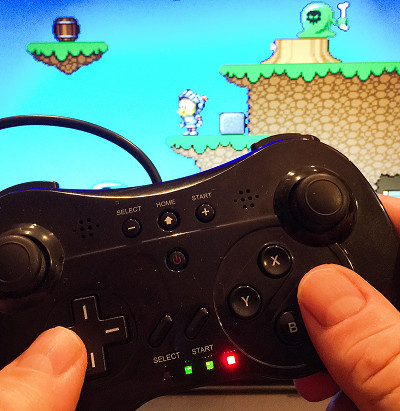 |
| Controller "prototype" |
Which turned out to be nothing more than a crappy third party Wii/Wii U controller.
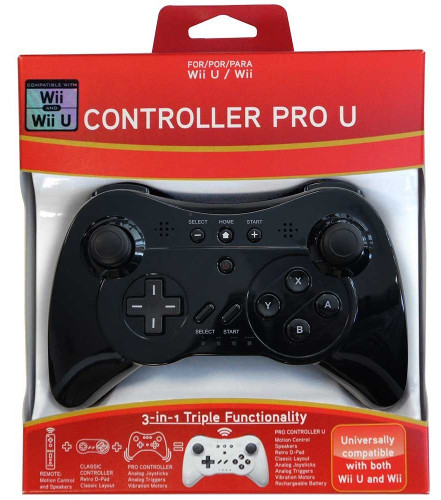 |
| Wii controller |
Using Indiegogo
Let's face it, using Indiegogo to do a crowdfunding campaign instead of Kickstarter is like using a generic supermarket cola rather than Coke in a beverage (or to use a more close to home analogy, using GameGavel instead of Ebay). They chose to go with Indiegogo at the last minute after learning that Kickstarter has clauses that require a working prototype to proceed with a campaign. This raised a lot of red flags with potential backers. In addition, Indiegogo requires people to part with their money immediately, rather than after something reaches their funding goal.
Pushing away those who can help you
Almost immediately after the launch of the Indiegogo, Kevtris, who was expected to provide the FPGA cores to the Retro VGS, unleashed a bombshell: he has already created a working prototype of the kind of console everyone expected the Retro VGS to be. Any momentum that the Retro VGS IGG campaign could have had through the retro gaming community was killed in an instant when he showed this off. This immediately begs the question: if Kevtris has already had extensive experience creating retro video game consoles, why didn't they come to some sort of deal with him to make the hardware for the system? Instead, it appears that the Retro VGS team decided to completely stop talking with Kevtris, leaving him and everyone else wondering what they were planning instead.
Perhaps more galling is SoCalMike abandoning his previous collaborators on the RetroGaming Roundup. The post speaks for itself:
This is a tough one for me, I was giddy with amusement for days but ultimately I had to remember the guy I knew and I hope is still in there somewhere. I can tell you one of the last times I spoke to Mike Kennedy, the one I knew, was the day before the first issue of RETRO Magazine arrived. During the ramp up to and during the Kickstarter he was still a part of RetroGaming Roundup and he utilized the shows reach on a constant basis to promote the Kickstarter for the magazine. There were many promises made about how the magazine would carry show material and advertisement in return. When issue #1 arrived it was devoid of any mention of the show other than low on a list of podcasts in gaming. UK Mike and myself called him to ask WTF and we got the most robotic sanatized catch phrase laden response that magazines just don't do those things. Since then I have only seen the old Mike once or twice, and I like that guy, heck I even miss him.
The simple truth is that Mike never wanted to defraud any customer, he had a dream to return gaming to the golden era and he intended to deliver every dollars worth to the backers. His downfall was to treat the close people who cared and could execute his ideas as expendible and look for the next best thing that told him what he wanted to hear. He created structures that cut out the most loyal and brought in lesser people, it happened to his mag and to his console. So he ended up with a smarmy moron who gave him a stack of buzzwords which was like handing a baby a loaded revolver. He is a true believer and had the guts to try to create something special, he just lost his way on the path. I think his idea is a good one, and perhaps one day he will get the right people to make it into a product. He isn't out to scam or cheat the end user because he puts himself in the shoes of that end user and wants something awesome. He needs to regroup and come back with a better machine and listen to his critics because they are right in the end.
The Price
When this console was first announced, it was assumed that it would cost about $150, and that games would be reasonably priced. However, about three weeks before the start of the IGG campaign, they announced that it was going to be $300-$350, with carts costing upwards of $60. By the time this console was planned to be finished, all of the current gen consoles would probably cost less than that, with a collection of high quality games that are cheaper. The Retro VGS team was hoping to get about 7000 people to buy in at this price, which is completely out of touch with the true demand for such a product. Needless to say, less than 200 people bought into this after the campaign started, and after the first day of hardcore supporters throwing their money in, the IGG campaign stalled.
The Indiegogo campaign
The Indiegogo campaign remains up as I write this, apparently because there is no way to actually cancel a fundraiser. This seems like a pretty crazy policy by IGG, but regardless, it is up. IGG has some oddities in that people who are donating must give the money right away (in Kickstarter, it only gets taken if the campaign is a success at the end), and that the campaign can get the money regardless of whether or not the goal is reached. It is at least honourable that the Retro VGS team chose to not go that route. Anyways, the campaign was a huge mess, with plenty of problems.
They made this list comparing the Retro VGS with other consoles:
 |
This comparison was one of the first things they featured on the IGG campaign. After a lot of derision, they did end up taking it down. I don't think I need to elaborate much about how ridiculous the comparison is. The most silly thing is how they regard the lack of system updates and patches as a positive.
They list a bunch of games that are supposedly in development for the Retro VGS. However, all of them, save for the launch title "The Adventures of Tiny Knight" are already available on platforms such as Steam, at a much lower cost than what they are offering. I don't think there are many people who would get excited about buying a >2 year old game (by the time the console is out). It is like when the N64 came out, and Crusin' USA was used as one of the initial releases. By that time, the game was not really that impressive.
After the backlash with the lack of hardware specs, they eventually did release some on the campaign website. However, though they always liked to say "this is not like the Ouya", they basically gave out specs that were nearly the same as the Ouya. At least when the Ouya came out, it had a collection of well known games like Sonic the Hedgehog 4 and Final Fantasy III, since porting Android games to the system was trivial.
One of the more outrageous parts of the IGG campaign was where the funding was going to go. They were basically using the campaign money to pay themselves a fairly high wage. They basically wanted to use the backer money to remove all risk for their own financial security. I'm sorry, but this is not really how a startup company works.
There are plenty of exaggerations in the the campaign, but none more ridiculous than their claims of 150 developers being interested developing for their non-existent console. At one point, they even claimed be in discussions to revive game series by Capcom, a company that has largely abandoned their most well known IP, and Konami, a company that is likely going out of the video game business altogether.
Finally, perhaps the most bizarre part of the IGG is the personnel descriptions, such as this:
John has degrees in computer science and management from St. Edward's University in Austin, and five degrees from De Anza College in Cupertino—where Apple co-founder Steve Wozniak studied.
How does the fact that Steve Wozniak attending that University have any relevance to this campaign? The only reason I can think of is that they are trying to make themselves sound more important than they already are.
Pandering to collectors
One thing that was very clear since the announcement of the Retro VGS is that SoCalMike is very focused on the collector community. Who can blame him? The value of Nintendo console games has skyrocketed during the past few years. This is very evident by the focus in the IGG campaign on different coloured consoles and low serial numbered consoles as part of the higher end rewards. However, once the IGG campaign started, there wasn't even a mention about it on the biggest collector forum, Nintendo Age, and when it finally caught on, it was met with a resounding "meh". The reason why the collector market is big is because people want to reminisce about their childhood, and live the dream of getting all the games. The Retro VGS should have focused on getting more interest in the gamer community rather than people who spend more time buying games than playing them.
Ignoring the backlash
What happened when people started to complain about the price of the Retro VGS, the switch to IGG, and the questionable tactics when advertising it? They called everyone "trolls" and deleted their comments from their Facebook site. You know, the phrase "the customer is always right" really comes to mind here. If potential customers are saying "$300 is too much", you might want to listen. Remember the backlash when the PS3 launched for $600? The customers said that was way too high, but they ignored them. It led that console to have an incredibly sluggish first year, until it was able to match the price of the Xbox 360. Same thing happened with the 3DS. However, both of these consoles had a library of exclusive games to entice potential customers. The Retro VGS didn't even have a working piece of hardware, or even more than one exclusive game.
The Jaguar shell
Finally, I think the most ridiculous thing that the Retro VGS team went on about was how much they were saving by reusing the Jaguar moulds. This is crazy, the single most expensive part of doing a video game system is without a doubt developing actual games. You know what people think when they see the Jaguar shells? They see the system that finally finished off Atari. Now they see Retro VGS, and they see even more failure.
How could the Retro VGS succeed?
After the failure of the Indiegogo, SoCalMike vowed to continue on. I don't want to be completely negative in my article, I think there is potential that a new console could work. But there are various things that they need to change.
Admit this is niche
SoCalMike and the rest of his team are dreamers. The thought of bringing back the console heyday of the early 90s is appealing to a lot of nostalgic people. But let's face reality, this isn't a product that has the backing of a huge corporation like Nintendo, Sony or Microsoft. They need to temper their expectations of how big this is going to be. The Ouya quickly failed, despite a one year turn around on the Kickstarter, and having some big name games available at launch. If they don't want to be like the Ouya, they need to target and pander to their niche.
Abandon the FPGA
After the IGG campaign started, kevtris found out there is a lot of interest in his FPGA system. However, he fully recognizes that his system is completely niche. With his system out there, there is almost no way the Retro VGS could make a FPGA system and compete with kevtris' years of experience. In addition, there also exists many emulator and clone systems that can already play existing cart based systems, so I think that including functionality to play old games for mainstream consoles is a dead end.
Forget about carts
How many people want to spend $40+ on an indie video game? Not many. Remember when the N64 came out? Though it had amazing games like Super Mario 64, multiplatform games were usually $20 more than the cheaper PS1 or Saturn equivalents. Most people would take a hit on graphics and loading times to have the game for much cheaper. There was a reason why Nintendo insisted that games be exclusive - it made for a hard sell. In 2015, the price of games is at a relative all time low. You can now buy high quality games for a dollar or two. Although physically owning something has value, the average game is just not worth $60 anymore. A revised Retro VGS should be a download-only system if it is going to have any chance. Unless...
Revive the Jaguar
This might be a bit crazy, but I think this is a more viable strategy than creating a new cart based system from scratch. The Atari Jaguar's hardware is apparently well documented and in the public domain. You have the shells, why not create a system that can play the actual games? Maybe make a system that is upgraded in some respects but is completely backwards compatible? Or make a system that could not only play carts, but also play games by downloading them? Actually, that should be a necessity. By reviving the Jaguar, you have a system that already has games, and already has a community that makes games for it. This would appeal to both collectors and people who need the nostalgia fix. The main thing that would be needed is a decent set of developer tools that could aid indie game makers.
Create a developer friendly, stable platform
One of the complaints heard from indie developers making games for platforms for the big three game makers is how difficult it is to get approval of games, and to patch games after the fact. Though the original IGG campaign made a big deal over how the Retro VGS would not allow for system and game patches, in 2015, with the ubiquity of the Internet, that is a ludicrous restriction. Make a stable platform with uniform hardware, and promise free and easy patching, and you might get a lot of interest from indie developers.
Gamers first, collectors second
I highly doubt that a console that is tailored towards collectors will succeed. Look what happened to the comic book industry when they started to pander to collectors - it alienated their entire audience, and never recovered. When making a console, it should really focus on what matters to gamers, high quality, visually appealing games. The game they showed off in the IGG campaign looked like a generic Amiga platformer (see below), not something that is going to attract a following. Ultimately, the majority of gamers don't care if they have a translucent shell for their console, or a low serial number. They are going to want a system for groundbreaking, fun games.
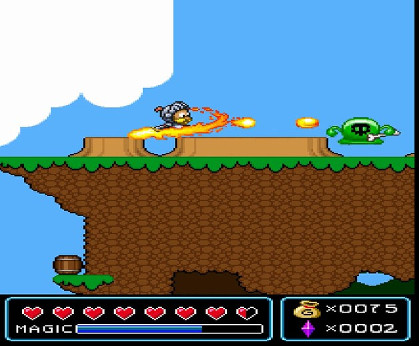 |
| Adventures of Tiny Knight, the first "exclusive" Retro VGS game |
Lower the price!
There is no way a niche console like the Retro VGS will succeed if it costs the same price as the current gen consoles. This thing needs to be more like $100 to be cheap enough for impulse purchase by gamers. Otherwise, they will pass it over for said current gen consoles, tablets, phones, and Steam. The only reason the Ouya succeeded at their Kickstarter is that it was at the key $99 impulse buy point.
Change the name
Retro VGS is a pretty damned generic name for a retro video gaming system. In marketing, you need something more punchy. I won't give any examples, but anything is better than Retro VGS.
Building bridges
SoCalMike has burned a lot of bridges in the run up to the IGG campaign by his outright hostility to complaints about the price and lack of transparency on the actual progress on hardware development. It is going to take a lot more than a bunch of hollow buzz phrases and hype to bring people back to the fold. For any future Kickstarter campaign, there is going to need to be a lot of transparency with their plan of bringing this to market. That is, they need to have a solid business plan. They need to have commitment from developers to bring out all original games, not just things that have been released on Steam or even old consoles. Most of all, they need to tell the truth. There was no way that big companies like Konami or Capcom are ever going to be interested in the Retro VGS, so don't make claims saying that you might attract their IP.
I think it is instructive to look at what Nintendo did in the run-up to the N64. They started to show off hardware and demos in 1993, some three years before its eventual release. Nintendo generated a lot of hype, but it really started to die off when the system was delayed multiple times. They really dampened developer interest by promoting the expensive cartridge format, most notably from key RPG maker, Square. They also were undercut when Sony reduced their royalty rates to something that was significantly less than what Nintendo charged. The N64 was a success, but predominately because Nintendo was at the top of their game in the late 2000s, and Rare gave them some essential exclusives, most notably Goldeneye. Their eroded developer relations contributed to the disappointing Gamecube, which really only had games that were graphical upgrades of N64 games.
The Retro VGS can't afford to follow the path that Nintendo took with the N64. They need to have good relations with third parties. Developing on the Retro VGS needs to be cost effective, and the user base needs to be large enough for them to make a profit. They need a concrete plan to release the console in a timely fashion, something that definitely did not look promising in their IGG campaign. They need to pander to gamers by having games from a wide variety of genres. They need to make the console cost effective by making cartridges at most optional, if not eliminated altogether. Finally, I think they need to get their own Super Mario 64. Without a system selling game, I can't see how this is ever going to get off the ground.